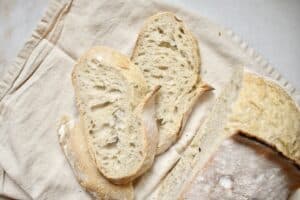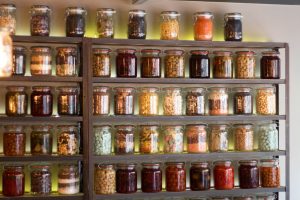Friends, GAPS has me feeling like I’m in a Dostoevsky novel. You know, back in the dark ages of medicine. The doctor exits from the patient’s room with a somber look and says something like, “I have bled her. And now the thing to be done is to wait. She will either recover, or die.” Most days, it feels like a struggle to survive the cure.
For my second week on the GAPS Intro Diet, I was able to move on to Stage 2. For me, this meant adding in eggs. I’ve had trouble with eggs in the past. A typical reaction for me includes eczema on my hands and digestive distress. I decided that I needed to be slow and deliberate so I took the entire week to incorporate eggs.
I started by adding raw egg yolks to my soup. Egg yolks have been compared to human breast milk because they can be absorbed almost entirely without any digestion at all. Start with one egg yolk per day added to a bowl of soup, and work your way up until you’re adding 1-2 egg yolks to each bowl of soup. You really can’t eat too many of them.
The thought of eating eggs raw is so taboo in our society, that I realize this may be a shocking thought for a lot of folks. The truth of the matter is (according to the National Egg Marketing Board in England) just about one egg in 7000 is contaminated with Salmonella bacteria–and these are the numbers for conventional eggs laid by battery hens in cages. Infected eggs come from infected chickens, so buying your eggs from a source that you trust is the key here. I get mine from a small, local farm and (bonus!) the eggs are also soy-free. Eggs laid by hens allowed to peck and forage and roam will give you added nutrition as well. If you need a little more convincing, this page has great information on the safety of raw eggs (about halfway down the page). And if the thought of raw eggs just makes you entirely too squeamish, you can cook them. They will be a bit less nourishing and bit harder to digest.
The way to add egg yolks to soup is to carefully separate the white from the yolk while warming your soup gently on the stove top. When your soup is just warm, drop the egg yolk into the soup and whisk quickly with a fork until it’s incorporated. Don’t let the soup get too hot or the yolk will cook.
I spent a few days trying out egg yolks and was delighted to find that they gave me no trouble. Up next–soft-boiled eggs.
Soft-boiled eggs are somewhat of a rarity these days, which is a shame because they’re completely delicious. A soft-boiled egg is an egg that has been boiled so that the whites are fully cooked but the yolk is not. It takes a bit of practice to figure out the exact timing (everyone seems to have their own method and number of minutes) but it’s super-easy once you’ve figured out your magic number. On my stove-top, I let the water come to a full boil, drop in the egg, boil it for exactly 6 minutes, then run it under cold water while I peel it.
The soft-boiled eggs can be mashed and mixed into your soup (my favorite method), or they can be eaten on their own with some soup or broth on the side. As it turns out, while I have no trouble with egg yolks, egg whites bring out the eczema on my hands. This isn’t unusual, since the whites contain complex proteins (which are difficult to digest) and antigens (those things your body thinks are invaders and cause allergic reactions). Most people with egg allergies are allergic to the whites. I tried them several different times to confirm the reactions I was having, and have decided that for now I need to leave out the egg whites and stick to the yolks.
At first I thought this meant I’d be stuck eating soup with egg yolks for weeks until my gut would accept egg whites. But when I went searching on Baden Lashkov’s (author of the GAPS Guide) blog, I found an encouraging note. She says if you cannot tolerate one of the recommended foods, to leave it out of your diet for a few days to allow your body to recover, skip it, and move on to the next step. Which is what I did.
So while week 2 was spent entirely on incorporating eggs, week 3 is looking a little more exciting (stew! casserole!). Maybe I can do this after all.
What I ate on Week 2 (Introduction Diet, Stage 2):
- more soup. I continued adding new veggies every other day or so. I added egg yolks to my soup. I tried adding egg whites, but reacted to them and have taken them out of my diet for now.
- Ginger and lemon tea. I started adding about a teaspoon of raw, unfiltered honey to each pot. I think this has given me a small energy boost and a little less brain fog.
- “Juice” from fermented veggies. I increased the amount I was eating from 1 teaspoon to 2 teaspoons without any trouble.
The supplements I took during Week 2 are the same as last week, but the quantities have changed:
- Hydrochloric acid before meals; I began Week 2 taking 4 capsules before every meal. By the end of the week I had reduced it to 3–a sign that my stomach acid is recovering.
- Having finished the super-strength probiotic course, I resumed my regular probiotic. I still split my dosage though, taking half in the morning and half at night, having learned my lesson the hard way in Week 1.
- I’m continuing to take my prescription meds.
Finally, I’m continuing to take a nightly detox bath. The detox baths have been so helpful to me in reducing my die-off symptoms. They also help me relax and manage my stress from the day–never a bad thing when you are trying to manage chronic illness.
So, how was I feeling? Still bad. Not horrible. Just bad.
My energy recovered slightly, but nowhere near previous levels. I still needed to rest often during the day, and we did a week of “light” homeschool (I let them do fun math workbooks, instead of teaching math lessons. You have no idea how much energy it takes to teach first and third grade math every day!)
I also still had a considerable amount of brain-fog. Completing thoughts, focusing on conversation or reading was very difficult.
Apart from these two things, and the reaction I had to the egg whites, I felt generally pretty great. I had none of my usual digestive pain or distress. Even the familiar bloating and distension was reduced slightly. I am hopeful for the future.
They say that week 3 is when you start truly feeling better. Onwards and upwards!
Basic Sauerkraut
An essential GAPS recipe, sauerkraut will provide you with lots of probiotic juice for Stages 1 and 2. <br>This is less of a formula and more of an art. Once you are comfortable with fermenting veggies, feel free to do some experimenting with adding different vegetables, fruits, herbs, and spices.
Source: Nourishing Traditions by Sally Fallon
Course: Fermented and Cultured Food
Main Ingredient: Vegetables
Serves:
Ingredients
- 1 medium cabbages cored and shredded
- 1 Tbs caraway seeds
- 1 Tbs sea salt
- 4 Tbs whey (or an additional 1 Tbs salt)
Directions
- In a bowl, mix cabbage with caraway seeds, sea salt and whey (if using). Pound with a wooden pounder or a meat hammer for about 10 minutes to release juices.
- Place in a quart-sized, wide-mouth mason jar and press down firmly with a pounder or meat hammer until juices come to the top of the cabbage. The top of the cabbage should be at least 1 inch below the top of the jar.
- Cover tightly and keep at room temperature for about 3 days before transferring to cold storage. The sauerkraut may be eaten immediately, but it improves with age.









